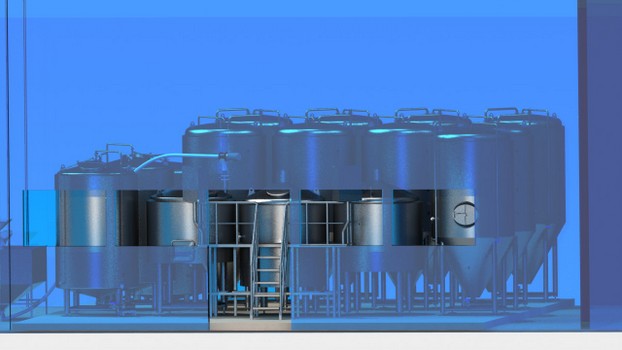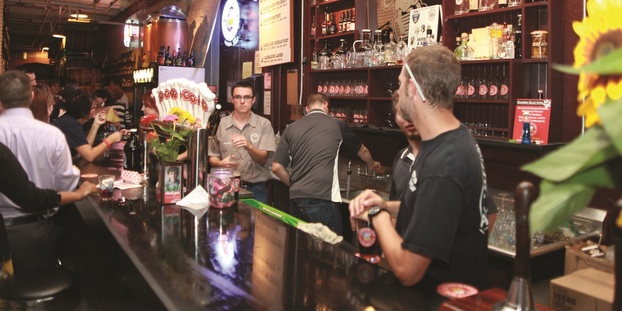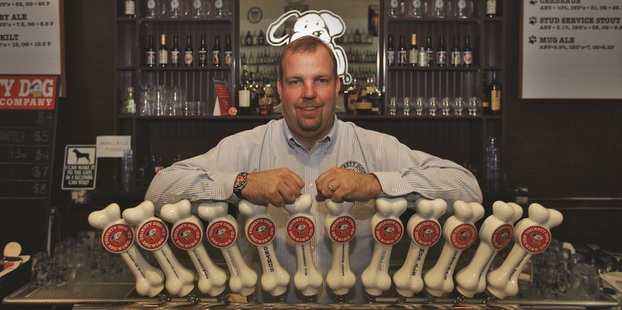In practically every big editorial feature, there are a few nuggets of information that don’t quite work themselves into the final piece. That doesn’t mean that info isn’t valuable or interesting. Instead of discarding these editorial tidbits left over from our “Tasting room tips” feature story, we’ve collected them here in a digestible list.
Food
Food was a topic that would pop up in our interviews — mostly because tasting rooms don’t offer food outside of snacks like peanuts, chips or popcorn. In fact, according to Eddie Leon, owner of MIA Brewing, a soon–to-open craft brewery in Miami, Florida tasting rooms are not allowed to have a kitchen. And it makes sense because these are tasting rooms, not brewpubs.
John Najeway, owner of Thirsty Dog Brewing Co., based in Akron, Ohio., allows people to bring their own food into the Thirsty Dog tasting room. And to his surprise, they do it. “It’s amazing to see people come in on Thursday or Friday with pizza or deli sandwiches, picnic baskets on a Saturday. They’re ready to camp out for a few hours and enjoy the different beers,” he said.
Going green
“We made sure and continue to make sure that folks know why we’re interested in the area, why we want to join the community and continue to stay in touch — whether it’s over a pint or having lunch … It’s not taking over a space, it’s integrating into that environment that’s doing so well.” — Ryan Arnold, communications manager for Sierra Nevada Sustainability is often a big bullet point for breweries, but Sierra Nevada found out that it was required for its planned tasting room in Berkley, Calif. Ryan Arnold, communications manager for Sierra Nevada, explained that Berkley has practically a zero waste policy. “Mercifully, it was already in line with some of the things we’ve practiced here in Chico,” he told us.
Sierra Nevada practices the four Rs of sustainability — recycle, reuse, reduce and rot. Last year, the brewery diverted 99.8 percent of its solid waste from landfills. Sierra Nevada will extend that structure to its tasting room to meet the Berkley Requirement.
Local law
One of the biggest tasting room factors is what state law requires brewers to have (or not have, in Florida’s no kitchen policy) in order to run a tasting room. Brewers must check their local regulations before planning their tasting rooms. These requirements can be anything from adding a handicapped accessible bathroom (or bathrooms) to ensuring that your brewery is properly zoned. Leon explained that to open MIA Brewing’s tasting room, he had to make sure the brewery was in an industrial-zoned location.
Capacity

As the feature pointed out, some brewers make the distinction between tasting room and bar. But one of the biggest distinctions is often the capacity of the tasting rooms. Among the brewers we spoke to, tasting room occupant capacities typically ranged from approximately 50 to 100 customers, excluding special events.
Leon was quick to mention though that building a big tasting room affords you the opportunity to sell more beer and increase your bottom line. “Obviously it gets more expensive the bigger you make the tasting room. It just needs to be as engaging and enjoyable a place as possible. You are going to be competing with other bars and restaurants. You have to make your place attractive,” he said.
Marketing
Many breweries do not go out of their way to market their brands, whether by choice or budget restrictions. For tasting rooms, the buzz in the local community is often driven by word of mouth. Najeway also put an emphasis on leveraging local events, community newspapers and social media. Building social media buzz is a big focus of MIA Brewing’s marketing campaign.

Local communication is also a big focus of Sierra Nevada. “We made sure and continue to make sure that folks know why we’re interested in the area, why we want to join the community and continue to stay in touch — whether it’s over a pint or having lunch,” Arnold explained. “We’re trying to gauge how people feel about us coming into Berkley and ensuring that they know that we want to encourage the community overall. It’s not taking over a space, it’s integrating into that environment that’s doing so well.”






Leave a Reply
You must be logged in to post a comment.